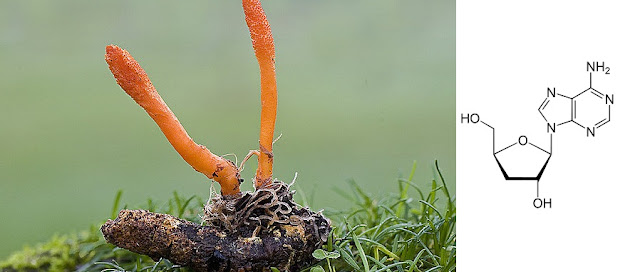‘Miracle’ Mushroom: Cordyceps sinensis - Based on Reliable Documents
Ophiocordyceps sinensis - Overview by Wikipedia:
Some of the most important benefits of the Cordyceps mushroom in traditional and modern medicine, are its positive effects on the heart pulse and heart arrhythmia (Ref. 2, Chapter “Effects on the Cardiovascular System”, pages 436 – 441).
Today, this mushroom is used in China as one of the first lines of defense when it comes treating serious heart diseases. Even though the way cordyceps works in controlling the arrhythmia is only partially known, it is considered that the greatest merit is the presence of adenosine.
It has been proven that these nucleosides have a positive effect on treating irregular heartbeat, slowing down heart rate and normalizing the heart rhythm. Cordyceps contains a significant amount of adenosine, deoxyadenosine and similar nucleosides.
Although herbal supplements have a different effects on different patients, there have been very few cases where arrhythmia has not been effectively treated after adding Cordyceps to the traditional therapy in patients.
Disclaimer: Always consult your physician before consuming any supplement. This general information is not intended to diagnose any medical condition. Consult with your doctor to receive an appropriate prescription.
Ophiocordyceps sinensis (formerly known as Cordyceps sinensis), is known in English colloquially as caterpillar fungus, or by its more prominent names yartsa gunbu (Tibetan: དབྱར་རྩྭ་དགུན་འབུ་, Wylie: dbyar rtswa dgun 'bu, literally "winter worm, summer grass"), or dōng chóng xià cǎo (Chinese: 冬蟲夏草) or Yarsha-gumba or Yarcha-gumba, यार्सागुम्बा (in Nepali language). It is an entomopathogenic fungus (a fungus that grows on insects) in the family Ophiocordycipitaceae. It is mainly found in the meadows above 3,500 meters (11,483 feet) in the Himalayan regions of Nepal, Bhutan, India and Tibet. It parasitizes larvae of ghost moths and produces a fruiting body which used to be valued as a herbal remedy. However, the fruiting bodies harvested in nature usually contain high amounts of arsenic and other heavy metals so they are potentially toxic and sales have been strictly regulated by the CFDA (China Food and Drug Administration) in 2016.
O. sinensis parasitizes the larvae of moths within the family Hepialidae, specifically genera found on the Tibetan Plateau and in the Himalayas, between elevations of 3000 m and 5000 m. The fungus germinates in the living larva, kills and mummifies it, and then a dark brown stalk-like fruiting body which is a few centimeters long emerges from the corpse and stands upright.
O. sinensis is classified as a medicinal mushroom, and its use has a long history in traditional Chinese medicine as well as traditional Tibetan medicine. The hand-collected, intact fungus-caterpillar body is valued by herbalists as medicine, and because of its cost, its use is also a status symbol.
This fruiting bodies of the fungus are not yet cultivated commercially, but the mycelium form can be cultivated in vitro. Overharvesting and overexploitation have led to the classification of O. sinensis as an endangered species in China. Additional research needs to be carried out in order to understand its morphology and growth habits for conservation and optimum utilization.
General Health Benefits of Cordyceps Mushroom
Cordyceps is a mushroom that grows in China where it is considered a miracle and you will see why. Here is what one of the world’s most potent mushrooms can offer in terms of health benefits.
The Cordyceps or “winter worm and summer grass” is a mushroom used in Chinese traditional medicine for over a thousand years. It grows at around 3500 meters above sea level, on the mountains in China.
The cordyceps mushroom consists of 77 micro and macro elements, unsaturated fatty acids, more than 80 types of enzymes, vital amino acids, vitamin A, C and E.
The general health benefits this mushroom offers are: its immune boosting ability, providing the body with strength and energy and slowing down the aging process.
Ophiocordyceps sinensis - Based on Reliable Documents: ‘Miracle’ Mushroom Fights Cancer & Diabetes And incurable diseases caused by sex
Due to its non-toxic compound, cordyceps is a great supplement for fighting the following diseases:#Cordyceps Benefit on Kidney Function
According to Chinese Taoist medicine, sexual lust will be affected by the kidneys. Sex, it affects Jing in three treasures: Jing, Qi, and Shen
In an unpublished study, the cordyceps mushroom was used as a treatment for alcoholic patients. The amazing discovery was that almost immediately after beginning the treatment patients lost their cravings for alcohol.
Further research confirmed this by proving that cordyceps improves the kidney function, helps removing urotoxin, prevents kidney infection and kidney stones.
In this study, 57 patients were treated with 4.5 mg of Cordyceps and managed to recover 89% of their kidney functions. As opposed to them, the controlled group recovered only 45% of normal kidney functions.
#Cordyceps and Regulation of Blood Sugar
One area where sufficient scientific research has been done is the Hypoglycaemic effect of the mushroom and blood sugar regulation.
In one trial 95% of the patients treated with 3 grams of cordyceps per day saw improvements in their blood sugar levels. For comparison, in the controlled group treated with traditional medication only 54% of the patient saw improvement in their blood sugar levels.
As a result, cordyceps is often recommended to diabetic patients as a supplement or as a sole treatment.
#Cordyceps as a Natural Antibiotic
Cordyceps mushroom has also been very effective against pathogenic bacteria and respiratory illnesses, such as chronic bronchitis and asthma (Ref. 2, Chapter “Effects on the Respiratory System”, pages 429-432). It is an excellent natural remedy for arthritis and rheumatism.
Cordyceps stimulates the blood circulation in a way that it steadily increases the blood flow in the coronary arteries which prevents blood clots or thrombus formation.
By lowering the cholesterol, cordyceps also helps against chronic fatigue (Ref. 1, Chapter “Effects on blood lipid metabolism and arteriosclerosis”, pages 299 – 301).
It contains large quantities of beta-carotene, vitamin E and C, mineral selenium and zinc, and coenzyme q10.
The mushroom stimulates the production of melatonin, the universal cancer-fighting antioxidant, making cordyceps mushroom very popular among large number of oncologist in the world as an anti-carcinogen supplement to the traditional treatments (Ref. 3).
Cordyceps stimulates the blood circulation in a way that it steadily increases the blood flow in the coronary arteries which prevents blood clots or thrombus formation.
By lowering the cholesterol, cordyceps also helps against chronic fatigue (Ref. 1, Chapter “Effects on blood lipid metabolism and arteriosclerosis”, pages 299 – 301).
It contains large quantities of beta-carotene, vitamin E and C, mineral selenium and zinc, and coenzyme q10.
The mushroom stimulates the production of melatonin, the universal cancer-fighting antioxidant, making cordyceps mushroom very popular among large number of oncologist in the world as an anti-carcinogen supplement to the traditional treatments (Ref. 3).
#The effects of Cordyceps on Cardiac Function
Some of the most important benefits of the Cordyceps mushroom in traditional and modern medicine, are its positive effects on the heart pulse and heart arrhythmia (Ref. 2, Chapter “Effects on the Cardiovascular System”, pages 436 – 441).
Today, this mushroom is used in China as one of the first lines of defense when it comes treating serious heart diseases. Even though the way cordyceps works in controlling the arrhythmia is only partially known, it is considered that the greatest merit is the presence of adenosine.
It has been proven that these nucleosides have a positive effect on treating irregular heartbeat, slowing down heart rate and normalizing the heart rhythm. Cordyceps contains a significant amount of adenosine, deoxyadenosine and similar nucleosides.
Although herbal supplements have a different effects on different patients, there have been very few cases where arrhythmia has not been effectively treated after adding Cordyceps to the traditional therapy in patients.
Disclaimer: Always consult your physician before consuming any supplement. This general information is not intended to diagnose any medical condition. Consult with your doctor to receive an appropriate prescription.
References:
1. Zhu, J.S., Halpern, G.M., and Jones, K. (1998): The Scientific Rediscovery of an Ancient Chinese Herbal Medicine: Cordyceps sinensis. Part I. Journal of Alternative and complementary Medicine4(3), pp 289-303.
2. Zhu, J.S., Halpern, G.M., and Jones, K. (1998): The Scientific Rediscovery of a Precious Ancient Chinese Herbal Regimen: Cordyceps sinensis. Part II. Journal of Alternative and complementary Medicine 4(4), pp 429-457.
3. The National Cancer Institute of Complementary and Alternative Medicine (OCCAM): Melatonin, Chronobiology, and Cancer
1. Zhu, J.S., Halpern, G.M., and Jones, K. (1998): The Scientific Rediscovery of an Ancient Chinese Herbal Medicine: Cordyceps sinensis. Part I. Journal of Alternative and complementary Medicine4(3), pp 289-303.
2. Zhu, J.S., Halpern, G.M., and Jones, K. (1998): The Scientific Rediscovery of a Precious Ancient Chinese Herbal Regimen: Cordyceps sinensis. Part II. Journal of Alternative and complementary Medicine 4(4), pp 429-457.
3. The National Cancer Institute of Complementary and Alternative Medicine (OCCAM): Melatonin, Chronobiology, and Cancer
4. Ophiocordyceps sinensis: https://en.wikipedia.org/wiki/Ophiocordyceps_sinensis
Learn more: Ackyard Pharmacy
Learn more: Ackyard Pharmacy






Sometime few educational blogs become very helpful while getting relevant and new information related to your targeted area. As I found this blog and appreciate the information delivered to my database.bioresonantie utrecht
ReplyDelete